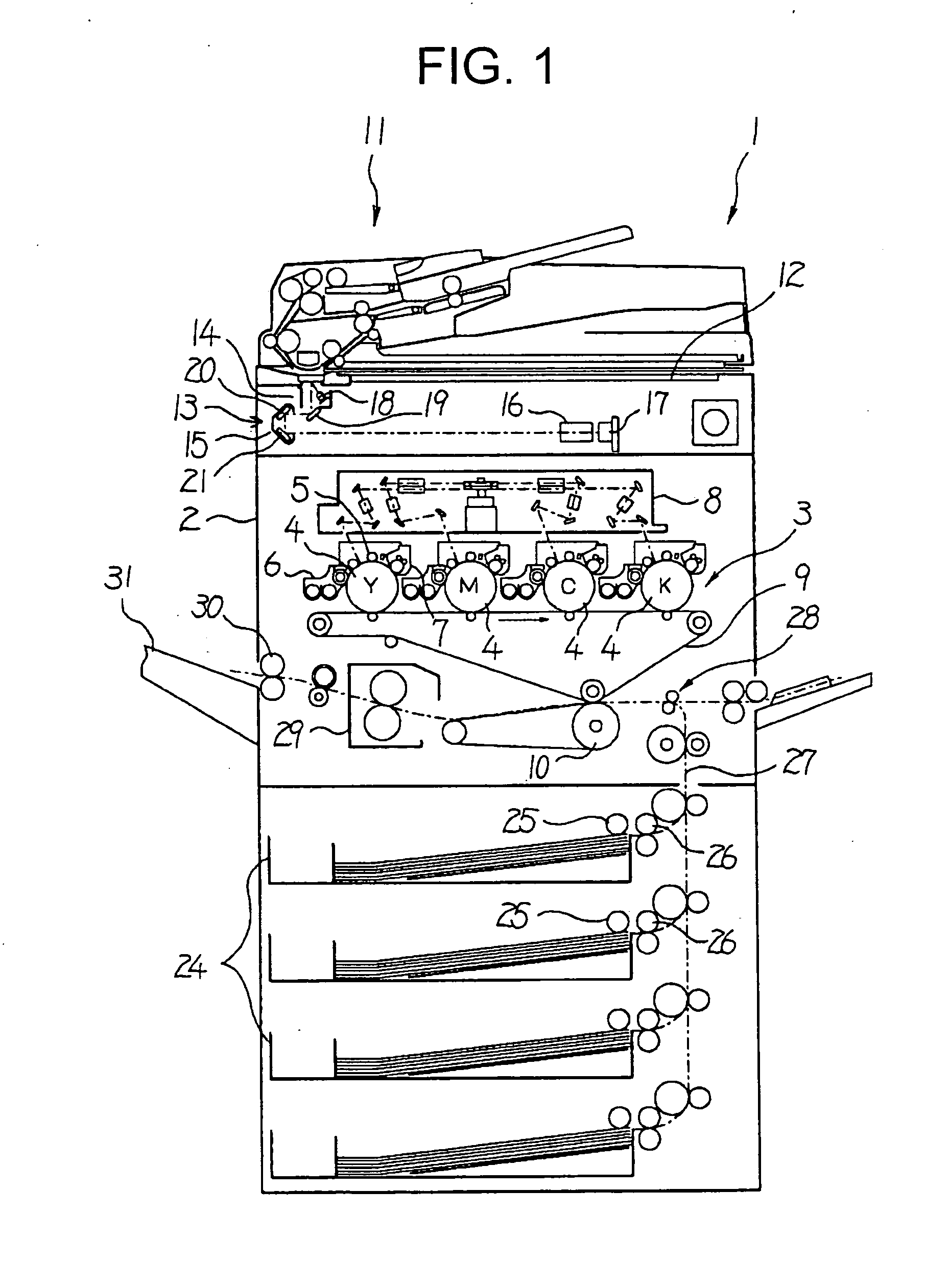Lighting device, image reading apparatus, and image forming apparatus
a technology of image reading and light source, which is applied in the direction of lighting and heating apparatus, lighting support devices, instruments, etc., can solve the problems of insufficient quantity of light, uneven image concentration due to illuminance ripple, and inability to read performan
- Summary
- Abstract
- Description
- Claims
- Application Information
AI Technical Summary
Benefits of technology
Problems solved by technology
Method used
Image
Examples
first embodiment
[0057] the present invention will be explained with reference to FIGS. 1 to 4. FIG. 1 is a schematic front view of an internal structure of a full-color copying machine 1 that is an image forming apparatus to which the present invention is applied.
[0058] An image forming unit 3 for forming a color image is provided in a central part in an apparatus body 2 of the copying machine 1. This image forming unit 3 includes: four drum-like photosensitive members 4 that are arranged in parallel horizontally to be spaced apart at an equal interval; charging rollers 5 that are arranged in outer peripheries of the respective photosensitive members 4 and form toner images on outer peripheral surfaces of the photosensitive members 4 with an electrophotographic process; developing devices 6; cleaning devices 7; an exposing device 8 that exposes the uniformly charged outer peripheral surfaces of the photosensitive members 4 to a laser beam according to image data to thereby form electrostatic latent...
eighth embodiment
[0107] the present invention will be explained with reference to FIGS. 14 and 15. A lighting device 75 in the eighth embodiment includes the plural LEDs 32 serving as point light sources, a condensing body 76, and a reflection mechanism 77.
[0108] The condensing body 76 is arranged in front in an emitting direction of rays emitted from the LEDs 32 and condenses the rays emitted from the LEDs 32 within a reading width in the sub-scanning direction when reading a document (within a width appropriate for a reading line width in the sub-scanning direction). In addition, in this condensing body 76, an incident side protrusion 78, in which diffused rays emitted from the LEDs 32 are made incident to be converted into parallel rays, a direct emitting portion 79, which directly emits the incident rays to a surface of a document, and a prism reflection surface portion 80, which reflects the incident rays to the reflection mechanism 77, are formed.
[0109] The reflection mechanism 77 is a tabula...
tenth embodiment
[0121] the present invention will be explained with reference to FIG. 18. A lighting device 85 of the tenth embodiment includes the plural LEDs 32 serving as point light sources, a condensing body 86, and the reflection mechanism 77.
[0122] The condensing body 86 is arranged in front in an emitting direction of rays emitted from the LEDs 32 and condenses the rays emitted from the LEDs 32 within a reading width in the sub-scanning direction when reading a document (within a width appropriate for a reading line width in the sub-scanning direction). In addition, in this condensing body 86, the incident side protrusion 78, in which diffused rays emitted from the LEDs 32 are made incident to be converted into parallel rays, a prism reflection surface portion 87, which reflects the incident rays toward a surface of a document, and an indirect emitting portion 88, which causes the incident rays travel toward the reflection mechanism 77, are formed.
[0123] The reflection mechanism 77 is a ta...
PUM
 Login to View More
Login to View More Abstract
Description
Claims
Application Information
 Login to View More
Login to View More - R&D
- Intellectual Property
- Life Sciences
- Materials
- Tech Scout
- Unparalleled Data Quality
- Higher Quality Content
- 60% Fewer Hallucinations
Browse by: Latest US Patents, China's latest patents, Technical Efficacy Thesaurus, Application Domain, Technology Topic, Popular Technical Reports.
© 2025 PatSnap. All rights reserved.Legal|Privacy policy|Modern Slavery Act Transparency Statement|Sitemap|About US| Contact US: help@patsnap.com



